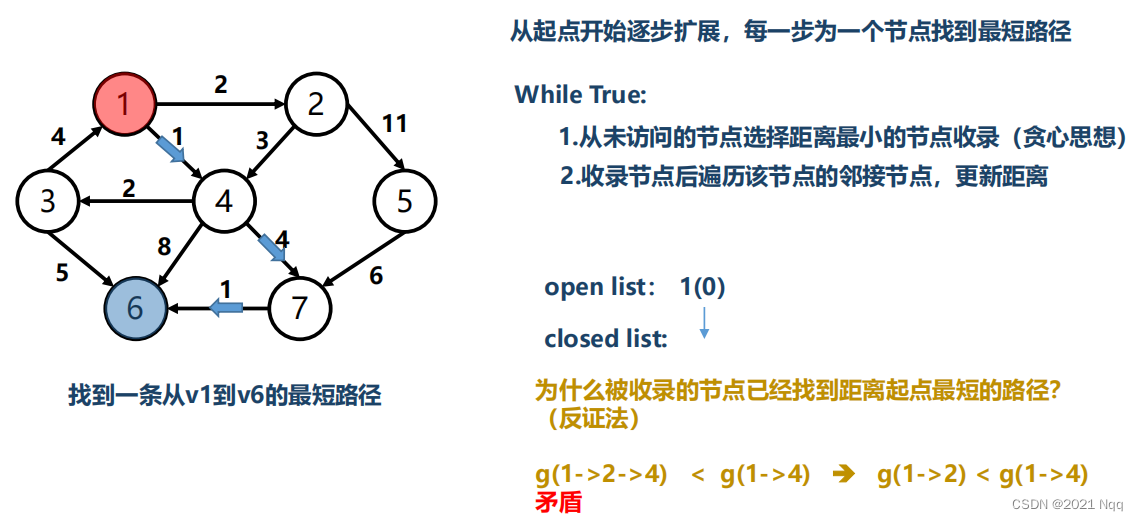最短路径算法性能优化:让你的算法飞起来,提升效率到极致
发布时间: 2024-08-27 23:15:17 阅读量: 70 订阅数: 50 


# 1. 最短路径算法基础理论
最短路径算法旨在寻找图中两个节点之间权重最小的路径。在计算机科学领域,最短路径算法有着广泛的应用,例如网络路由、地图导航和物流配送等。
最短路径算法的基本原理是通过迭代更新节点的距离,逐步逼近最短路径。常见的算法包括 Dijkstra 算法、Bellman-Ford 算法和 Floyd-Warshall 算法。其中,Dijkstra 算法适用于非负权重的图,Bellman-Ford 算法适用于存在负权重的图,而 Floyd-Warshall 算法则适用于所有类型的图。
# 2. 最短路径算法性能优化策略
### 2.1 数据结构优化
#### 2.1.1 邻接矩阵与邻接表
**邻接矩阵**
- **数据结构:**二维数组,行列表示图中的顶点,元素表示顶点之间的权重。
- **优点:**查询效率高,时间复杂度为 O(1)。
- **缺点:**空间复杂度高,对于稀疏图(边较少)浪费空间。
**邻接表**
- **数据结构:**数组,每个元素是一个链表,链表中的节点表示与该顶点相连的边。
- **优点:**空间复杂度低,对于稀疏图节省空间。
- **缺点:**查询效率低,时间复杂度为 O(V),其中 V 为顶点数。
**选择建议:**对于稠密图(边较多),使用邻接矩阵;对于稀疏图,使用邻接表。
#### 2.1.2 堆与优先队列
**堆**
- **数据结构:**完全二叉树,其中每个节点的键值都小于或等于其子节点的键值。
- **优点:**查询最小值或最大值的时间复杂度为 O(1),插入或删除元素的时间复杂度为 O(log V)。
- **缺点:**需要维护堆的结构,操作复杂。
**优先队列**
- **数据结构:**基于堆实现,提供插入、删除和查询最小值或最大值等操作。
- **优点:**操作简单,时间复杂度与堆相同。
- **缺点:**需要额外的空间存储堆结构。
**选择建议:**对于需要频繁查询最小值或最大值的算法,使用优先队列;对于不需要频繁操作的算法,使用堆。
### 2.2 算法优化
#### 2.2.1 启发式搜索
**原理:**利用启发式函数估计目标节点的距离,引导搜索过程。
**优点:**对于某些问题,可以显著提高搜索效率。
**缺点:**启发式函数的准确性影响算法的性能。
#### 2.2.2 近似算法
**原理:**牺牲精确性来提高效率,得到一个近似最优解。
**优点:**对于大规模问题,可以大幅缩短计算时间。
**缺点:**解的质量无法保证。
#### 2.2.3 并行算法
**原理:**将问题分解成多个子问题,同时在多个处理器上并行计算。
**优点:**对于大规模问题,可以大幅提高计算速度。
**缺点:**需要解决数据同步和负载均衡等问题。
**代码示例:**
```python
import heapq
class Graph:
def __init__(self, vertices):
self.vertices = vertices
self.edges = [[] for _ in range(vertices)]
def add_edge(self, u, v, weight):
self.edges[u].append((v, weight))
def dijkstra(self, start):
distance = [float('inf')] * self.vertices
distance[start] = 0
pq = [(0, start)]
while pq:
current_distance, current_vertex = heapq.heappop(pq)
if current_distance > distance[current_vertex]:
continue
for neighbor, weight in self.edges[current_vertex]:
new_distance = current_distance + weight
if new_distance < distance[neighbor]:
distance[neighbor] = new_distance
heapq.heappush(pq, (new_distance, neighbor))
return distance
```
**逻辑分析:**
- `Graph` 类表示图,`vertices` 为顶点数,`edges` 为邻接表。
- `add_edge` 方法添加一条边。
- `dijkstra` 方法实现 Dijkstra 算法,使用优先队列 `pq` 存储待访问的顶点。
- 算法从起始顶点开始,不断更新距离,并使用优先队列选择距离最小的顶点进行访问。
- 算法结束时,`distance` 数组存储了从起始顶点到所有其他顶点的最短距离。
# 3. 最短路径算法性能优化实践
### 3.1 Dijkstra算法优化
Dijkstra算法是一种广泛应用于求解单源最短路径问题的贪心算法。然而,在处理大规模图时,其时间复杂度可能成为性能瓶颈。为了优化Dijkstra算法的性能,提出了多种优化策略。
#### 3.1.1 斐波那契堆优化
斐波那契堆是一种基于斐波那契数列的最小优先队列数据结构。它比传统的二叉堆具有更快的插入和删除操作,从而可以显著提高Dijkstra算法的效率。
**优化原理:**
斐波那契堆的优化原理在于,它将节点组织成一组有序的斐波那契树。每个节点都有一个键值,代表到源节点的距离。当需要从堆中提取最小键值时,斐波那契堆通过合并树的方式快速找到最小键值节点。
**代码实现:**
```python
import heapq
class FibonacciHeap:
def __init__(self):
self.min_node = None
self.num_nodes = 0
def insert(self, key, value):
new_node = Node(key, value)
self.min_node = self._merge(self.min_node, new_node)
self.num_nodes += 1
def extract_min(self):
if self.min_node is None:
return None
min_node = self.min_node
self.min_node = self._merge_children(self.min_node)
self.num_nodes -= 1
return min_node.value
def _merge(self, node1, node2):
if node1 is None:
return node2
if node2 is None:
return node1
if node1.key < node2.key:
return self._merge_children(node1, node2)
else:
return self._merge_children(node2, node1)
def _merge_children(self, parent, child):
child.next = child
child.prev = child
if parent.child is None:
parent.child = child
else:
child.next = parent.child
child.prev = parent.child.prev
parent.child.prev = child
child.prev.next = child
parent.degree += 1
return parent
class Node:
def __init__(self, key, value):
self.key = key
self.value = value
self.next = self
self.prev = self
self.child = None
self.degree = 0
def dijkstra_fibonacci_heap(graph, source):
dist = [float('inf')] * len(graph)
prev = [None] * len(graph)
visited = [False] * len(graph)
heap = FibonacciHeap()
heap.insert(0, source)
dist[source] = 0
while heap.num_nodes > 0:
u = heap.extract_min()
visited[u] = True
for v in graph[u]:
if not visited[v]:
alt = dist[u] + graph[u][v]
if alt < dist[v]:
dist[v] = alt
prev[v] = u
heap.insert(alt, v)
return dist, prev
```
**参数说明:**
* `graph`: 输入图,表示为邻接表形式。
* `source`: 源节点。
**代码逻辑分析:**
1. 初始化斐波那契堆并插入源节点。
2. 循环从堆中提取最小键值节点,并将其标记为已访问。
3. 对于当前节点的每个相邻节点,计算到源节点的替代距离,并更新距离和前驱信息。
4. 将相邻节点插入堆中,并更新其键值。
5. 重复步骤2-4,直到堆为空。
#### 3.1.2 二叉堆优化
二叉堆也是一种常用的优先队列数据结构。与斐波那契堆相比,二叉堆的插入和删除操作效率较低。然而,在某些情况下,二叉堆优化后的Dijkstra算法仍能获得不错的性能提升。
**优化原理:**
二叉堆优化的原理在于,它将节点组织成一棵完全二叉树。每个节点都有一个键值,代表到源节点的距离。当需要从堆中提取最小键值时,二叉堆通过下滤操作快速找到最小键值节点。
**代码实现:**
```python
import heapq
def dijkstra_binary_heap(graph, source):
dist = [float('inf')] * len(graph)
prev = [None] * len(graph)
visited = [False] * len(graph)
heap = []
heapq.heappush(heap, (0, source))
dist[source] = 0
while heap:
u = heapq.heappop(heap)
if visited[u[1]]:
continue
visited[u[1]] = True
for v in graph[u[1]]:
if not visited[v]:
alt = dist[u[1]] + graph[u[1]][v]
if alt < dist[v]:
dist[v] = alt
prev[v] = u[1]
heapq.heappush(heap, (alt, v))
return dist, prev
```
**参数说明:**
* `graph`: 输入图,表示为邻接表形式。
* `source`: 源节点。
**代码逻辑分析:**
1. 初始化二叉堆并插入源节点。
2. 循环从堆中提取最小键值节点,并将其标记为已访问。
3. 对于当前节点的每个相邻节点,计算到源节点的替代距离,并更新距离和前驱信息。
4. 将相邻节点插入堆中,并更新其键值。
5. 重复步骤2-4,直到堆为空。
### 3.2 A*算法优化
A*算法是一种基于启发式搜索的路径查找算法,广泛应用于求解最短路径问题。通过使用启发式函数估计到目标节点的距离,A*算法可以显著减少搜索空间,从而提高算法效率。
#### 3.2.1 IDA*算法
IDA*算法是一种深度优先搜索算法,它结合了A*算法和深度优先搜索的优点。IDA*算法通过迭代地增加搜索深度,逐步逼近目标节点,从而避免了A*算法中可能存在的无限循环问题。
**优化原理:**
IDA*算法的优化原理在于,它将搜索空间划分为多个层级,并逐步增加搜索深度。在每一层级中,IDA*算法使用A*算法进行搜索,直到达到当前搜索深度或找到目标节点。如果未找到目标节点,则回溯到上一层级并增加搜索深度。
**代码实现:**
```python
def ida_star(graph, source, target, heuristic):
bound = heuristic(source, target)
while True:
path, cost = search(graph, source, target, 0, bound)
if path:
return path, cost
bound = cost
def search(graph, source, target, g, bound):
if source == target:
return [source], g
f = g + heuristic(source, target)
if f > bound:
return None, f
min_cost = float('inf')
path = None
for neighbor in graph[source]:
new_path, cost = search(graph, neighbor, target, g + 1, bound)
if new_path:
if cost < min_cost:
min_cost = cost
path = [source] + new_path
return path, min_cost
```
**参数说明:**
* `graph`: 输入图,表示为邻接表形式。
* `source`: 源节点。
* `target`: 目标节点。
* `heuristic`: 启发式函数。
**代码逻辑分析:**
1. 初始化搜索深度界限。
2. 循环增加搜索深度界限。
3. 在每一层级中,使用A*算法进行搜索,直到达到当前搜索深度或找到目标节点。
4. 如果未找到目标节点,则回溯到上一层级并增加搜索深度。
5. 重复步骤2-4,直到找到目标节点。
#### 3.2.2 SMA*算法
SMA*算法是一种基于A*算法的实时搜索算法。它通过动态调整启发式函数,以适应环境的变化,从而提高算法的效率和鲁棒性。
**优化原理:**
SMA*算法的优化原理在于,它将启发式函数分为
# 4. 最短路径算法性能优化案例分析
### 4.1 大型路网最短路径计算
#### 4.1.1 数据预处理优化
**问题描述:**
大型路网最短路径计算面临着数据量庞大、计算复杂度高的挑战。数据预处理优化通过对路网数据进行预处理,降低算法的计算复杂度。
**优化策略:**
* **路网分块:**将路网划分为多个子块,每个子块包含一定数量的节点和边。通过分块,可以减少算法在搜索过程中需要遍历的节点和边数量。
* **路网简化:**移除路网中不重要的节点和边,例如流量较小的道路。简化后的路网具有更小的规模,降低了算法的计算复杂度。
* **路网索引:**构建路网索引,例如空间索引或哈希索引,以快速查找节点和边。索引可以减少算法在搜索过程中查找节点和边的时间复杂度。
#### 4.1.2 并行计算优化
**问题描述:**
大型路网最短路径计算通常需要耗费大量时间。并行计算优化通过利用多核处理器或分布式计算平台,将计算任务并行执行,提高计算效率。
**优化策略:**
* **并行 Dijkstra算法:**将 Dijkstra 算法并行化,将路网划分为多个子块,每个子块由不同的处理器或计算节点负责计算。
* **并行 A*算法:**将 A* 算法并行化,将启发式搜索和优先队列操作并行执行。
* **分布式计算:**将路网最短路径计算任务分配到分布式计算平台,例如 Hadoop 或 Spark,利用集群中的多台机器并行计算。
### 4.2 实时导航系统最短路径计算
#### 4.2.1 启发式搜索优化
**问题描述:**
实时导航系统需要快速计算最短路径,以提供及时准确的导航信息。启发式搜索优化通过使用启发式函数引导搜索过程,减少算法的搜索空间。
**优化策略:**
* **A*算法:**A* 算法使用启发式函数估计节点到目标节点的距离,将搜索重点放在最有可能包含最短路径的区域。
* **IDA*算法:**IDA* 算法是一种深度优先搜索算法,使用启发式函数对搜索深度进行限制,避免陷入死胡同。
* **SMA*算法:**SMA* 算法是一种基于内存的启发式搜索算法,利用历史搜索信息来优化搜索过程。
#### 4.2.2 近似算法优化
**问题描述:**
在某些情况下,实时导航系统对最短路径的精确度要求不高。近似算法优化通过牺牲一定程度的精确度,换取更快的计算速度。
**优化策略:**
* **ε-近似算法:**ε-近似算法计算一条长度不超过最短路径长度(1+ε)倍的路径,其中ε是一个预定义的近似误差。
* **随机算法:**随机算法通过随机生成路径并评估其长度,来获得近似最短路径。
* **基于采样的算法:**基于采样的算法从路网中随机采样节点和边,并基于采样结果估计最短路径长度。
# 5. 第五章 最短路径算法性能优化趋势与展望
随着科技的不断发展,最短路径算法的性能优化也在不断探索新的方向。以下是一些未来可能的发展趋势:
### 5.1 量子计算与最短路径算法
量子计算是一种利用量子力学原理进行计算的新型计算技术。与传统计算机相比,量子计算机具有并行性和叠加性等特性,这使其在解决某些复杂问题时具有显著优势。
在最短路径算法领域,量子计算可以用于优化算法的搜索空间。传统算法需要遍历所有可能的路径,而量子算法可以通过叠加态同时探索多个路径,从而大幅减少搜索时间。
### 5.2 人工智能与最短路径算法
人工智能技术,如机器学习和深度学习,可以用于优化最短路径算法的决策过程。通过训练模型,算法可以学习最佳的搜索策略和启发式函数,从而提高算法的效率和准确性。
例如,在大型路网最短路径计算中,人工智能模型可以根据历史数据和实时交通状况,预测最优的路径选择,从而减少计算时间和提高路径质量。
### 5.3 云计算与最短路径算法
云计算是一种通过互联网提供计算资源和服务的模型。云计算平台可以提供大规模的并行计算能力,这可以用于加速最短路径算法的计算过程。
通过将算法部署到云平台,可以利用云平台的弹性资源分配和自动扩展能力,根据需求动态调整计算资源,从而提高算法的吞吐量和响应时间。
此外,云平台还提供了丰富的工具和服务,如分布式存储、消息队列和机器学习平台,这些资源可以帮助开发者快速构建和部署高性能的最短路径算法解决方案。
0
0





